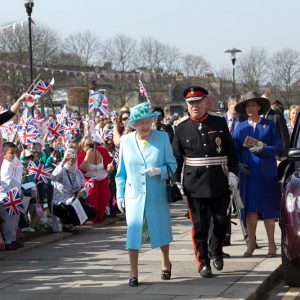In 2012 the Queen celebrated her Diamond Jubilee. She came to the throne on 6 February 1952 (her Coronation took place on 2 June 1953). The only other British monarch to celebrate a Diamond Jubilee was Queen Victoria in 1897.
National celebrations centred around the first week in June and further details of the Diamond Jubilee can be found here.

Her Majesty’s Diamond Jubilee Regional Tour – North London, 29th March 2012
Her Majesty’s Diamond Jubilee Regional Tour to Greater London
The Queen and The Duke of Edinburgh made two separate one-day visits to Greater London. On Thursday 29th March they visited three locations in north London. In the morning they travelled to Valentines Mansion in
Redbridge to view the start of a four-day festival and exhibition celebrating Art and Design in London over the last six decades. Exhibitors included the Design Museum, Saatchi Gallery, Tate Gallery, Central St Martins School of Art & Design and London Metropolitan University.
Then they travelled to Waltham Forest Assembly Hall where they attended a Reception and Lunch for ‘Achievers’ nominated from across the whole of north London.
In the afternoon they moved to the Krishna Avanti School in Harrow to attend a specially commissioned community event. The event celebrated both London’s tradition and its growing diversity during her reign. The Royal Couple were treated to dance and music demonstrations from community

er Majesty’s Diamond Jubilee Regional Tour – South London, 15th May 2012
groups and schools showcasing the various ages, abilities, faiths and nationalities in Harrow, the most religiously diverse borough in the UK. A photographic exhibition highlighting ’60 faces of London’ served to underline the changes that have taken place over the last 60 years.
A second day visit took place on Tuesday 15th May when The Queen and The Duke of Edinburgh visited south London. An exhibition in Bromley highlighted London as a global centre of fashion. South London ‘Achievers’ were recognised at a lunch in Merton. In Richmond Park a ‘Wild London’ event served to underline how the green spaces throughout the Capital have been used for recreation, inspiration and conservation.
Greater London Black Poplars
Holland Park was at the centre of London’s civic calendar on Friday 2 December 2011 as Mayors from across the Capital came to launch Greater London’s Diamond Jubilee Celebrations.
Organised by HM Lord-Lieutenant of Greater London, Sir David Brewer, representatives of all 32 London boroughs, and the City of London, were in the Royal Borough of Kensington and Chelsea to receive black poplars, which were then planted throughout London, to mark The Queen’s Diamond Jubilee in 2012. Sir David Attenborough assisted with the distribution.
The trees used to be a common sight across England, but are now an endangered species. The Queen has recognised this and has had saplings planted on her estates and in the Royal Parks.
The idea to use black poplars came from Sir David Brewer, who approached Roger Jefcoate, one of the country’s leading experts on black poplars for help.
The black poplar [Populus nigra betulifolia], a large native tree, used to flourish across the whole of England but is now rare. Prior to 1850 (when they were still being planted) the trees were heavily involved in British industry. Naturally fire resistant and generally resilient, the timber has been found in buildings, carts and wagons, scaffolding, farm equipment and matches. Black poplar wood has also been identified in floorboards and arrows on the Mary Rose and in First World War rifle butts. The tree appears iconically in John Constable’s famous 1821 painting, The Hay Wain.


